Engaged Anthropology Grant: Christopher Hewlett
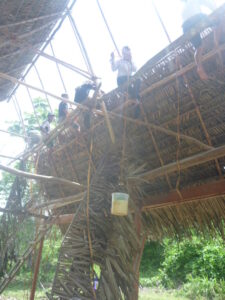
While a doctoral student at the University of St. Andrews Christopher Hewlett received a Dissertation Fieldwork Grant in 2009 to aid research on “Mobility, Sociality, and Perceptions of Time among the Amahuaca of Lowland Peru,” supervised by Dr. Peter Gow. In 2014 Dr. Hewlett received an Engaged Anthropology Grant to aid engaged activities on “Amahuaca Cultural Heritage Centre: Anthropological Engagement with Amahuaca People in the Past, Present and Future”.
The original engagement grant project entailed working with Amahuaca people in the Peruvian Amazon to establish a cultural center in the Native Community of Nuevo San Martin on the Inuya River. The idea for the cultural center stemmed from a conversation with Professor Carlos Melendez Piño, an Amahuaca bilingual teacher, during the late stages of my doctoral research (2009-2011). In the course of this conversation Professor Melendez pointed to an empty lot next to his house, saying that this was where he wanted a cultural center for the community to be constructed. As I left the Inuya River to write my doctoral thesis I told Professor Melendez and other members of the community that I would seek funding to build the cultural center.
During the course of my research on Amahuaca history during the 20th century I was fortunate to have the cooperation of Robert Russell, the founder of the first mission for Amahuaca people in the 1950s, and anthropologists Robert Carneiro and Joseph Woodside who carried out research in the 1960s and 1970s respectively. I was able to gain access to extensive archival materials based on their research including video and audio recordings, photos and descriptions of collective life, as well as details pertaining to the lives of individuals during the period from the 1940s to 1980s.
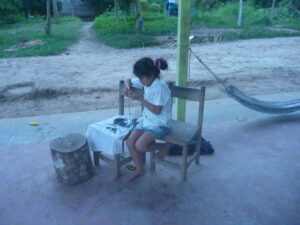
In July of 2015 I returned to the Inuya River with this material to begin work on the project. We set out with four primary aims. Firstly, to create a space where Professor Melendez and other Amahuaca people could store and display artefacts of their cultural heritage such as pottery, bows & arrows, photos and other audio-visual materials. As part of the preparation for the center, Professor Melendez and I looked for further material, and we located a collection of historical photos held in a Dominican archive in Lima, which we hope will be included in the cultural center at some time in the future.
Preparations also included Amahuaca people themselves engaging in practices that were no longer part of everyday life such as making pottery, headdresses, necklaces, armbands and painting themselves. These activities relate to the second aim, which was for Amahuaca people to use the making of material culture as a way to engage in conversations about culture more broadly, and to reflect on the ways in which their relationship to their past relates to contemporary life. Thus, we hoped that the processes of making materials for the cultural center would facilitate wider discussions regarding both material and immaterial cultural heritage. This proved to be an important part of the process, and led to some important additions to the original project, which I return to below.
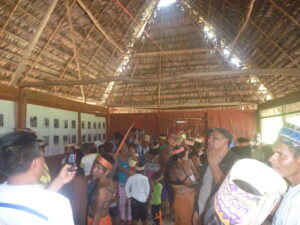
The third aim of the project was to make the cultural center an educational space where young people could learn about their past through photos and videos, as well as participate in the making of their own adornments. This was highly successful as young people made their own adornments, and enthusiastically participated in all aspects of the project.
Finally, it was hoped that the center would become a space where tourists could visit to learn about Amahuaca people’s culture, past and present, as well as create a market for Amahuaca goods. Although there are not many tourists in this area, occasionally groups do visit the community and there is a movement in the region to expand tourism thus opening up new opportunities for indigenous people.
As the project progressed over the course of several months new ideas were expressed and a series of opportunities emerged that would transform the original idea into something more comprehensive. Firstly, it was decided that the cultural center should be made more inclusive and, thus, the name was changed from Amahuaca Cultural Center to the Casa de Cultura Indígena. This would allow the inclusion of Yaminahua and Ashaninka people, who are neighbors and friends of Amahuaca people.
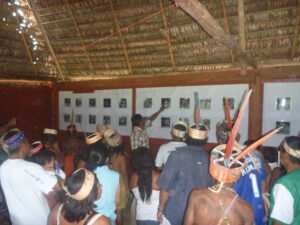
Secondly, this discussion regarding inclusion resulted in the idea of forming an indigenous federation that would incorporate all the Native Communities in this area. In the end, the organizing idea created a platform for celebrating the history and culture of this particular area, which was used to bring together these groups of people to form a new political organization that would represent them both socially and politically.
Thirdly, through contacts with a network of indigenous leaders and NGOs we began coordinating with ProPurus, an organization initiating a new project on the Inuya and Mapuya Rivers that entails helping with land-titling processes, establishing committees to monitor logging, and strengthening protection of areas where people live in isolation. The idea of this new project is to include indigenous people living near the adjacent protected areas to play a role in their protection, thus building the capacities of those who participate, raising awareness about those living in isolation, and increase the potential for getting greater support for community projects.
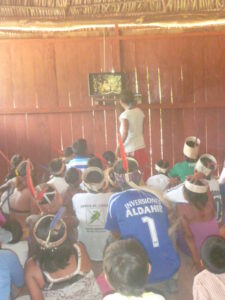
Finally, as momentum built around the Casa de Cultura Indígena it was decided that a film should be made about this process. As a result, we raised additional funds and invited Fernando Valdivia, an award-winning Peruvian film-maker, to document the inauguration of the Casa de Cultura Indígena, the formation of the new federation and interview those working to monitor logging in protected areas.
The three-day event took place from the 25th-27th of November 2015, and included three major components: formation of a new indigenous federation, the inauguration of the cultural center, and a celebration that included food, manioc beer, and a soccer tournament. Fernando Valdivia filmed the proceedings and we aim to have the documentary completed by the beginning of 2017.
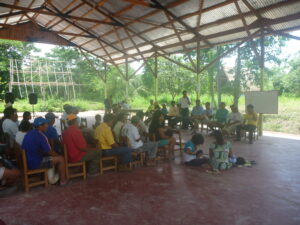
The meeting to form the federation was organized for the first day of the event and included leaders from the five native communities: Nuevo San Martin (Amahuaca), San Juan (Amahuaca), Alto Esperanza (Amahuaca), Raya (Yaminahua), and Paujilero (Ashaninka). Importantly, leaders of the two largest regional indigenous organizations OIRA and CORPIAA based in the provincial capital of Atalaya participated to assist with the proceedings, and officially recognize the newly formed Indigenous Federation of the Upper Inuya and Mapuya Rivers. It is the first of its kind in this specific area, as it is comprised exclusively of leaders from the five participating Native Communities.
On the second day of the event, the Casa de Cultura Indígena was officially inaugurated. Amahuaca, Yaminahua, Ashaninka and others gathered together to sing the Peruvian national anthem, speak about the importance of indigenous identity and history, and thank those who had worked to make the Casa de Cultura Indígena possible. In addition, representatives from government ministries, the local university, and members of the public attended to show support for the communities. The Casa de Cultura Indígena is the first cultural center to be established in the province, and promotes opportunities for those living on the Inuya and Mapuya Rivers to claim greater ownership of the ways in which they are represented. Furthermore, it is a project that is not yet completed, and will continue to develop over time. This includes the completion of the documentary film and its incorporation as part of the exhibition, as well as the inclusion of Ashaninka and Yaminahua materials.
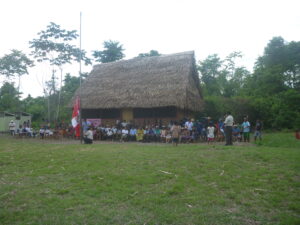
Overall, the combination of engaging in the practices of making pottery, body adornments, and other material artifacts, as well as working together to build the Casa de Cultura Indígena itself, became part of a wider experience that inspired people across communities to reflect on their past and come together to forge a path for the future. Thus, the idea of the cultural center, first expressed in 2011, became the impetus for a much more expansive and inclusive series of projects that are based on collective work towards the documentation, defense and strengthening of indigenous identities in the area, which we hope will continue to develop in the coming years.